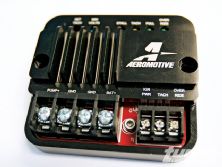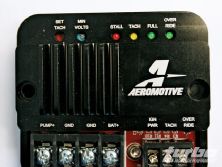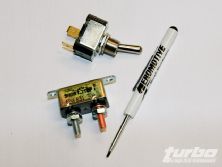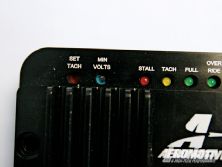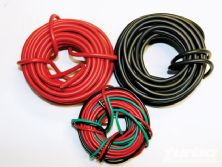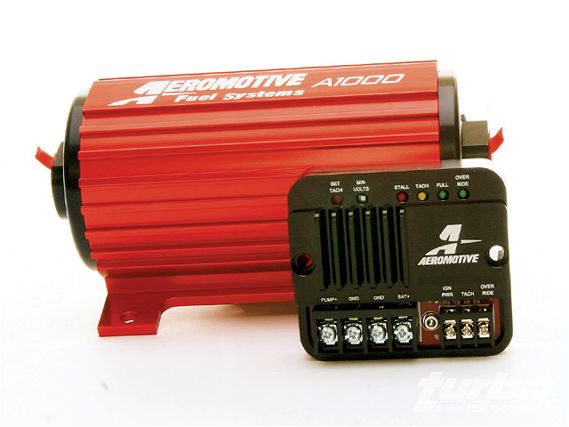 | Aeromotive Fuel Pump Speed Controller - Tech
| Aeromotive Fuel Pump Speed Controller - Tech
At first glance, the Aeromotive Fuel Pump Speed Controller (FPSC) looks like a simple black box filled with LEDs, screws, and resistors, but you'll be surprised to know that it's so much more. This state-of-the-art electric fuel pump control module was recently released by Aeromotive as the second-generation controller, replacing the previous model that serviced the race community for a stellar eight years. The new FPSC was designed to provide the end user with ease of programming, plus its use of pulse modulation reduces pump speed without harming the motor and ultimately its function in order to allow large, high-flow fuel pumps to be street driven by minimizing fuel heating that can rob a vehicle of horsepower and performance. "The motivation for the FPSC redesign was primarily to enhance operation and the user interface, while reducing size and weight," Brett Clow says, Aeromotive engineer. "Additional desired benefits included reduced build time and costs, along with enhanced serviceability."
Why Use The Aeromotive FPSC
"Ultimately the purpose of installing the Aeromotive billet FPSC is to control the fuel recycle rate and minimize heat transfer from the engine compartment into the fuel and thereby back to the tank," Clow says. Interestingly, reduced fuel heating in the tank is the purpose of today's "returnless" fuel systems, but with significant reduction in fuel system performance. As a side bar, "returnless" fuel systems are totally EPA driven with respect to evaporative emission control (EEC) standards. Not to say that the Aeromotive FPSC is an EEC device, or that it would eliminate fuel heating completely, but it does in fact reduce residual fuel heating in the tank in order to extend the driveability of a high-performance fuel system and as a bonus helps reduce the tendency for hot-fuel vapors to pollute the environment for the more environmentally conscious. Added benefits when using the Aeromotive FPSC include extended pump service life and quieter operation at lower rpm when cruising the streets.
Not Your Typical Boost-A-Pump Or Quick Fix Bandage Setup
There is a difference between the Aeromotive FPSC and products from other companies that boost voltage to the pump. The FPSC and boost-a-pump controllers are based on two completely different designs. In the case of a boost-a-pump unit, the concept is simple: The unit increases voltage above the fuel pumps rated voltage, increasing pump speed and thereby flow rate, and is essentially a bandage for a deficient fuel pump capacity to engine flow requirement. This is a popular stepping stone to increased fuel delivery to support more power, but the downside to using this type of setup is that fuel pump service life can be significantly shortened. Ultimately, installing the correct fuel system, including the right fuel pump, filters, fuel lines, fuel rails, and pressure regulator, is the only way to ensure that your performance machine gets adequate fuel.
"Surge tank systems are another bandage for a fuel tank that is not appropriately designed for the engine's (fuel system's) fuel flow requirements," Clow says. "Anyone using a surge tank system should strongly consider the new Aeromotive FPSC P/N 16306 to control the pump feeding off the surge because the size of a surge tank, in addition to the fact that it is separate from the main tank, requires extra care to avoid hot fuel handling problems. The use of a properly sumped fuel tank, using a specialized baffled sump like the Aeromotive P/N 18650, in conjunction with the FPSC P/N 16306, and a proper Aeromotive fuel system, combine to create a far more effective fuel system solution compared to multiple pumps and multiple tanks, not to mention cost efficiency."
The Aeromotive FPSC Advantage
Bottom line: You need to put enough fuel through the rail to feed the engine at a given load with enough leftover to keep the return line flowing and the pressure stable. Any flow over and above this is not absolutely required at that specific moment in time, but when you factor in the complexity of anticipating what the driver will do with his foot, it is wise not to slow the pump too much or one risks a dangerous lean condition. By utilizing a conservative but effective strategy that is user configurable with respect to base pump voltage followed by a progressive increase in duty cycle to a user-determined, high-rpm threshold, the new Aeromotive FPSC allows priority engine fueling with nominal fuel recycling. All the while, the pulse modulation strategy is totally friendly to the electric motor with the net effect of both extending fuel pump service life and further quieting pump operation.
We asked Clow his thoughts of the drawbacks of whether not using correct wiring or power to a fuel pump will affect the car's performance just as much as using a small inefficient pump. He said that was a pertinent question with respect to overall fuel system execution and that ultimately the system and its components are only as good as the installation. Failure to properly plumb and wire an Aeromotive high-performance fuel system is responsible for 98 percent of the difficulty people experience after the fact. This is simply critical and it's a crime, not to mention expensive, when the key details like proper wiring are allowed to render an otherwise capable fuel system unable to perform as advertised.
Aeromotive Inc.
www.aeromotiveinc.com

